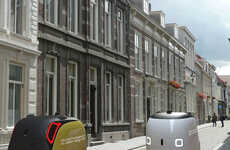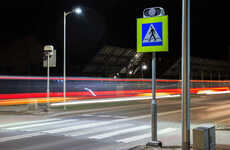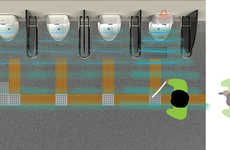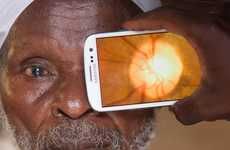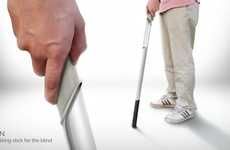
This Road Printer Efficiently and Effectively Paves a Path for the Blind
Amelia Roblin — December 6, 2013 — Autos
References: hebust.edu.cn & red-dot.sg
You may have noticed those little raised lines along train station platforms and sidewalks. These are what the Blind Road Printer produces. Currently, large international cities install these with complex and cumbersome machinery, but this 2013 Red Dot Design Award winner proposes a simpler process.
This compact robotic vehicle is equipped with sensors and detection feedback that guide it towards the ideal location for raised pavement markings. An intelligent operating system and a rechargeable battery enable the application and creation of the yellow bumps with a 3D printer in the base.
Specific instructions can be fed into Hao Cong's Blind Road Printer so that it can produce embossed lines both straight and curved. The invention would make it easier and cheaper to enhance the urban environment with these tangible features, affording the visually impaired safety and a better notion of their physical environment.
This compact robotic vehicle is equipped with sensors and detection feedback that guide it towards the ideal location for raised pavement markings. An intelligent operating system and a rechargeable battery enable the application and creation of the yellow bumps with a 3D printer in the base.
Specific instructions can be fed into Hao Cong's Blind Road Printer so that it can produce embossed lines both straight and curved. The invention would make it easier and cheaper to enhance the urban environment with these tangible features, affording the visually impaired safety and a better notion of their physical environment.
Trend Themes
1. Automated Road Marking - The development of street-marking robots presents an opportunity for automated road marking processes that are more efficient and cost-effective.
2. Sensory Feedback Technology - The integration of sensors and detection feedback in robotic vehicles like the Blind Road Printer offers disruptive innovation possibilities in various industries, enabling enhanced precision and accuracy in various applications.
3. 3D Printing for Infrastructure - The use of 3D printing technology in the construction and infrastructure industry, as demonstrated by the Blind Road Printer, opens avenues for faster and more customizable production of tactile features for the visually impaired.
Industry Implications
1. Transportation - The street-marking robot technology can revolutionize the road maintenance industry by automating road marking processes, reducing costs, and improving overall efficiency.
2. Robotics - The incorporation of sensory feedback technology in robotic vehicles like the Blind Road Printer showcases disruptive advancements in the robotics industry, offering potential applications beyond road marking.
3. Construction - The integration of 3D printing technology in infrastructure projects, as seen in the Blind Road Printer, presents disruptive innovation opportunities in the construction industry, enabling faster and more precise creation of tactile features.
3.7
Score
Popularity
Activity
Freshness



